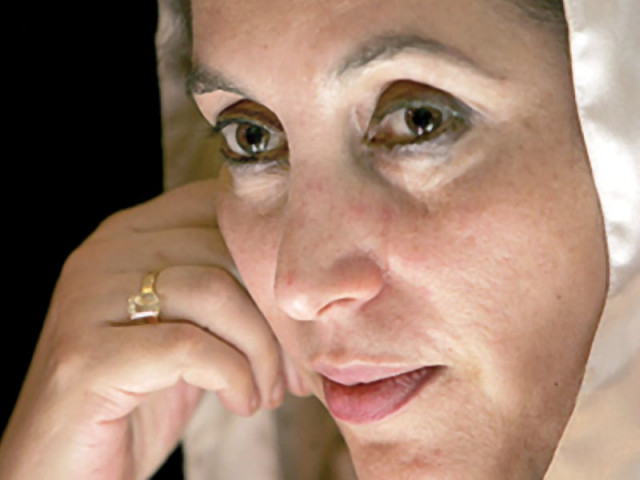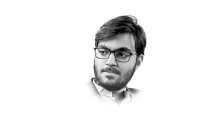The mythological life and death of Benazir Bhutto
Benazir’s legacy is little known among the Pakistani youth

PHOTO: EXPRESS
All of this sounds like an ancient mythological tale. Benazir’s life and death resemble that and have been explored as such by Anna Suvorova, who heads the department of Asian Literature at the Institute of Oriental Studies of the Russian Academy of Sciences, Moscow. Suvorova is no stranger to Pakistan and has years of research to her credit. Originally published in Russian, her book, Benazir Bhutto: A Multidimensional Portrait, has been translated and printed by Oxford University Press, Pakistan. As an anthropological study, Suvorova places Benazir in the wider cultural context and takes the reader through the maze of not just the Bhutto family and its roots, but also the norms with respect to women. Prevalent practices, such as honour killings, acid attacks, rape, and so on, dot the milieu within which Benazir, an otherwise privileged woman, emerged and fought as a democratic leader.
Benazir Bhutto’s persona was multi-faceted and paradoxical: from her elite, dynastic status, to that of being at the receiving end of a repressive post-colonial state. This was complicated further by her ‘Western’ side and the imperatives of a dupatta-clad Sindhi woman negotiating democracy, secular ideals and the embedded religiosity of Pakistani society. Her legacy, therefore, is as mixed as the complexity that she had to straddle in her public life. Suvorova’s study is not a conventional biography and in her own words is an “image of Benazir Bhutto that emerges at the intersection of history, culture and myth-making”. While being an inheritor of her father’s bravado-laden politics, Benazir displayed far more flexibility and accommodation. She was also criticised for that. Conversely, her brothers chose a more radical path by setting up al-Zulfiqar, a militant organisation that was also accused of hijacking a Pakistani aircraft; and became an excuse for the Zia regime to persecute thousands of PPP workers.
In an exclusive chapter, Suvorova brings together the polarised debates on the Bhutto siblings. We have the Benazir loyalists’ versions, and Fatima Bhutto’s heartfelt Songs of Blood and Sword that challenges all of that. Suvorova looks at the tension between the Bhutto siblings (Benazir-Murtaza) by invoking the work of eminent psychologist Alfred Adler (1870-1937). Suvorova struggles to remain balanced in her account and succeeds to a great extent. Adler’s framework of sibling positions also helps us understand Mir Murtaza’s dislike for Asif Ali Zardari, though there were solid political reasons for the disagreements as well. Murtaza’s murder, ‘rumoured’ as the handiwork of Benazir’s controversial husband Zardari (who later became her defacto successor and remains so), is a recent urban legend. Even though a high-level judicial commission exonerated both, the popular perception remains unchanged. This is where mythology intersects the murkiness of political assassinations in Pakistan. Years later, there were also accusations against the ex-president of having his wife murdered and the folklore to this effect refuses to disappear even when religious extremists accepted the responsibility of Benazir’ assassination.
Nusrat Bhutto, another heart-wrenching leaf from the Bhutto family legend, also remained divided. Her love for the son Murtaza was well known and the book even mentions a quote from a newspaper interview after Murtaza’s arrest (Benazir was in power then) where Nusrat Bhutto complains how her daughter had “become a little dictator” and “paranoiac about her brother”.
The last chapter, “The Story Ends; Begins the Legend” is an apt reminder of the metamorphosis of Benazir’s legacy and persona. For her detractors, she was “corrupt”, one who squandered “opportunities” for change and promoted her controversial husband. For her large number of loyalists, she is viewed as the brave heroine who was a victim of Pakistan’s oppressive state institutions. Suvorova’s own assessment is charitable as she mentions how Benazir struggled against “the prejudices of patriarchal society” and the “predominant male sexism in religion and politics … and Islamic extremism and fanaticism”.
Ironically, Benazir’s legacy is little known among the Pakistani youth. They have learnt their history from dubious textbooks and media sources. For instance, Benazir’s welfare interventions still employ more than 100,000 women as health workers at the community level. Their work comprises a silent revolution of sorts. Similarly, the entry of more women in public spaces can be traced to her courage that even her worst enemies acknowledge. Today, nearly half the student body in Pakistan’s public-sector universities is female. Many have to negotiate with patriarchal norms and conservatism, but they are marching on. Even at the global level, in the current contestations between Islam and Western public opinion, Benazir’s book, Reconciliation: Islam, Democracy and the West (2008), provides a critical voice and ideas for a way forward. Yet, her willingness to play along with the Taliban policy of the deep state or ignore stories of corruption leaves indelible question marks. Suvorova has traced the evolution and splintering of the Benazir ‘legend’. Her murder was predictable. It is getting clearer that until there is a structural change within the Pakistani state, trial[s] of her murder may not deliver “justice”. Suvorova opens many windows for future writers and historians. While the translation could have been better, for the richness of its material and hybrid style, the book is a valuable reference for contemporary Pakistani cultural studies.
Published in The Express Tribune, September 20th, 2015.
Like Opinion & Editorial on Facebook, follow @ETOpEd on Twitter to receive all updates on all our daily pieces.
















COMMENTS
Comments are moderated and generally will be posted if they are on-topic and not abusive.
For more information, please see our Comments FAQ